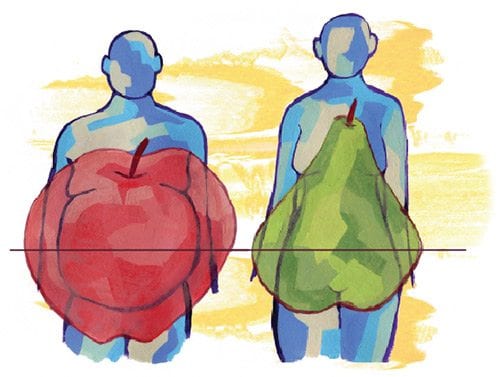
The name metabolic syndrome is uncommon but the condition is not. According to a recent study published in the Journal of the American Medical Association, nearly 35 percent of all U.S. adults and 50 percent of those 60 years of age or older were estimated to have the condition in 2011-2012.
Traits of Metabolic Syndrome
Large waist circumference
- 35 inches or higher for women
- 40 inches or higher for men
High triglyceride level — at least 150 mg/dL, or if on treatment for high triglycerides
Reduced HDL cholesterol in mg/dL
- Less than 40 for men
- Less than 50 for women
Increased blood pressure — at least 130/85 or if taking blood pressure medications
Elevated fasting blood sugar — at least 100 mg/dL or on medications to control high glucose
Metabolic syndrome, also referred to as Syndrome X, is a cluster of five conditions that occur together, thereby increasing the risk of heart disease, stroke and diabetes. Abnormal levels of cholesterol and triglycerides are smack in the middle of it.
The five conditions are low HDL cholesterol, high triglycerides, increased blood pressure, high blood glucose levels and excess body fat around the waist. Each condition by itself can be damaging enough to health, but when additional conditions are thrown into the mix, the risk of the complications increases. The National Heart, Lung, and Blood Institute defines the syndrome as the simultaneous existence of three or more of the conditions.
Most threatening is that, although a person can have three or more of these disorders lurking, there’s a high probability that he or she will be unaware of it. For the most part they have no symptoms. Those will high glucose levels may experience increased thirst or problems with vision, but often, even advanced cases of diabetes are silent. A large waist is a tell-tale sign, but the average person would not associate a larger than average waist to heart disease.
Several factors increase the risk of metabolic syndrome. It occurs more frequently in people over the age of 60. Although it is common in people of all races, Hispanics and Asians are more frequently targeted. Women who had gestational diabetes or diabetes during pregnancy, or those with a family history of type 2 diabetes are of greater risk than the general public.
The good news is that aggressive lifestyle changes can often prevent the incidence of metabolic syndrome, or control it if diagnosed. It’s a common foursome that’s often repeated because it applies to almost every health condition — exercise, weight loss, healthy eating and smoking cessation. General recommendations are 30 minutes a day of moderate-intensity exercise; a healthy eating plan that includes fruits, vegetables, whole grains and healthy fats; a 5 to 10 percent weight loss; and complete abstinence from all tobacco products. Even one cigarette a day is too much, according several studies
If these changes do not do the trick, medications are available to help control blood pressure, cholesterol and glucose levels. Medications are even available to quash the desire to smoke.
The most severe threat of metabolic syndrome is that it’s a harbinger of a slew of life-threatening illnesses. It’s a wake-up call that if changes to lifestyle and adherence to medication are ignored, more devastating illnesses are waiting down the line.







